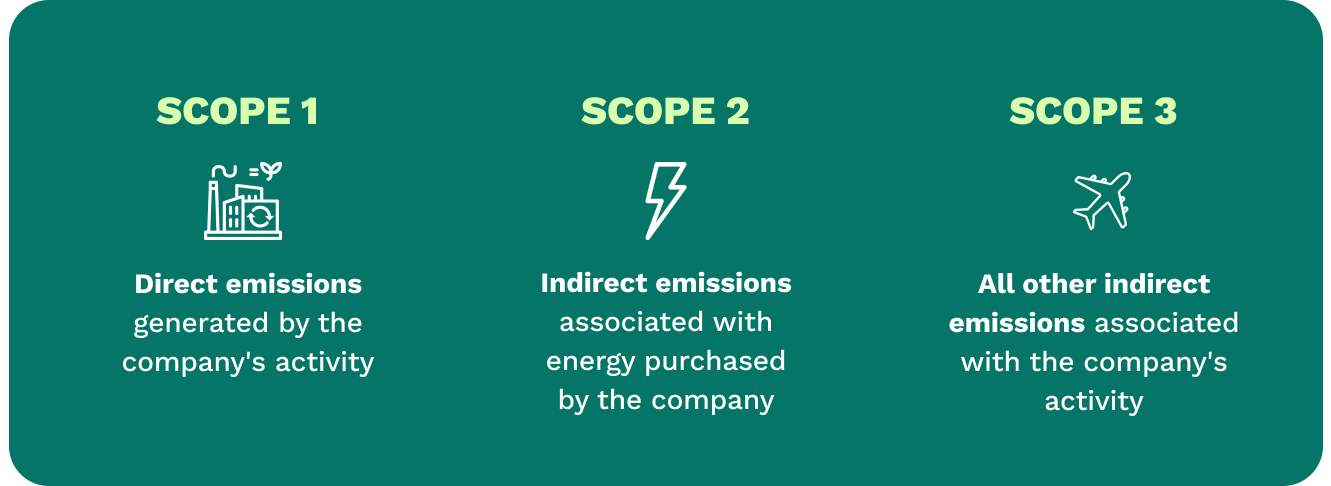What you need to know about corporate carbon footprint
Companies are increasingly committing to an environmental strategy, whether to anticipate future regulations or to outline their commitment to fight against global warming. A CSR (Corporate Social Responsibility) business model can be a real lever to enhance your image and build loyalty among your partners and employees, but where to start?
A carbon footprint assessment is the first step towards a robust environmental strategy for companies. In this article, we review what a carbon footprint measurement is, why, and how to do it.
What is a GHG footprint assessment?
A Greenhouse Gas (GHG) footprint is an assessment of the amount of greenhouse gasses emitted (or captured) into the atmosphere, over a reference period, by the activities of an organization or a territory.
In France, it is often referred to as Bilan Carbone®, a standard developed by The French Agency for Ecological Transition (ADEME).
Why measure your carbon footprint?
It has become necessary to change the way we produce and consume if we want to continue to live on a healthy and habitable planet. We can already see the disastrous repercussions of global warming on our civilizations: famines, displacement of populations, degradation of human health, water shortages, etc...
The IPCC (Intergovernmental Panel on Climate Change) warns of these repercussions and urges governments to drastically reduce their greenhouse gas (GHG) emissions to achieve the objectives of the Paris Agreement and limit global warming to 1.5°C compared to the pre-industrial era.
Individuals and companies, therefore, have a duty to measure their carbon footprint and take the necessary steps to reduce their emissions, in the short term, and contribute to global carbon neutrality in the long term.
This transition must be accompanied by concrete actions, the first step being to identify one's own sources of emissions to be able to reduce them: we cannot reduce what we have not measured.
But what are the specific steps to properly measure your carbon footprint?
Which perimeter do we need to consider for carbon footprint measurement?
To assess its GHG, several perimeters are taken into account:
- The operational perimeter, all direct and indirect emissions generated by the company's activity.
- The organizational perimeter, all the company's sites, and facilities.
- The temporal perimeter, the carbon footprint covers a specific period, delimited in time.
Emissions are divided by scope (Scope 1, 2, & 3) or by emission items depending on the methodology. These categories correspond to the operational scope.
What are the scopes of application?
Scope 1 represents direct GHG emissions and takes into account the sources that are directly controlled by the company. This is the most limited scope and includes emissions related to the company's production process, fuel used for the process, air conditioning, and the company's vehicle fleet.
Scope 2 represents indirect GHG emissions from the production of electricity purchased and consumed by a company. This includes the electricity and steam required to manufacture a product or provide a service, and therefore includes the energy production associated with a product or service.
Scope 3 takes into account all other indirect emissions generated by the organization. This is the broadest scope, looking at the rest of the company's value chain (upstream and downstream activities). For example, we analyze emissions from the transportation of goods, waste management, business travel, supplier emissions or purchasing policy, etc.

A decree signed by the Minister for Energy Transition on July 1 2022 makes it mandatory to account for and report all significant indirect emissions, thus including so-called "scope 3" emissions.
In France, regulations require companies with more than 500 employees to measure their greenhouse gas emissions at least once every four years.
Assessing your carbon footprint with ClimateSeed
ClimateSeed enables companies to carry out their carbon footprint by offering a hybrid solution integrating a digital platform, GEMS (GHG Emissions Management Software), and the expertise of experts consultants. The GEMS platform facilitates data collection and collaboration with stakeholders, and performs automated calculations based on recognised international standards (GHG Protocol, Bilan Carbone®, ISO 14064).
The results enable reduction strategies to be drawn up in line with scientific objectives (SBTi), accelerating organisations' transition to global carbon neutrality. GEMS includes sub-modules tailored to different business sectors and company sizes.
For more information, click here.
CSRD, the new European directive
Adopted in December 2022 and in effect since January 1, 2024, the CSRD represents a significant expansion of the scope of mandatory non-financial reporting for companies within the EU.
The CSRD applies to a wide range of European and non-European companies, depending on the category of companies.
Specifically, it will be applied in several stages. For more information, we invite you to read our dedicated article.
Source: ADEME - Site Bilans GES
Frequently asked questions
To get started on your organization's carbon footprint, follow these key steps:
Define the scope: Identify the activities, sites and sources of emissions to be included in the carbon footprint.
Collect data: Gather data on energy consumption, vehicle emissions, raw material consumption, etc.
Calculate emissions: Use specific emissions factors to convert consumption data into CO₂ emissions.
Analyze results: Evaluate major emissions items and identify reduction opportunities.
Plan actions: Develop an emissions reduction strategy based on the analysis.
Implement and monitor: Implement reduction measures and monitor their effectiveness over time.
It is advisable to call on the expertise of a specialist service provider such as ClimateSeed to measure your carbon footprint accurately and to benefit from advice tailored to your sector and your specific requirements. Please contact us for further details.
Please contact us if you would like more information.
Share this
You May Also Like
These Related Stories

What can my Company do to Reduce its Carbon Emissions?

The Role of Biochar Beyond Nature-based Solutions

.webp?width=600&height=829&name=Download%20Guide%20measure%26reduction%20EN%20(1).webp)
